Vicente Calderón: (Atlético Madrid)
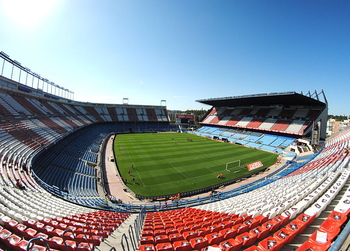
By BruceW. [CC BY-SA 2.0], via Wikimedia Commons
Club Atlético de Madrid is more commonly known as Atlético Madrid or simply just Atlético. The football club was formed in the Spanish capital in 1903 and has called the Vicente Calderón Stadium home since it opened in 1967. The are the city rivals of Real Madrid and are generally considered be second to Real in most areas, including their home grounds. The Vicente Calderón was built to replace the Estadio Metropolitano de Madrid and to rival Real Madrid’s more spectacular Santiago Bernabéu Stadium that had opened in 1947.
In order to finance the new ground the club had to make a debt issue in the form of mortgage bonds that were mostly underwritten by the team’s shareholders and members. When it first opened it was named Estadio del Manzanares, owing to the fact that it was built on the banks of the Manzanares. It was changed to Vicente Calderón Stadium in honour of a famous former president of the the club.
Stats
| Vicente Calderón Stats | |
|---|---|
| Year Opened | 1967 |
| Capacity | 54907 |
| Average Attendance | 44290 |
| Pitch Size | 105 x 70 (7350) |
| Former Name | Manzanares Stadium |
| Owner | Atlético Madrid |
| Clubs Hosted | Atlético Madrid |
| First Fixture | Atlético Madrid v Valencia (02/10/1966) |
| Final Fixture | Atletico Madrid 3 -1 Athletic Bilbao (2017) |
Vicente Calderón Photos
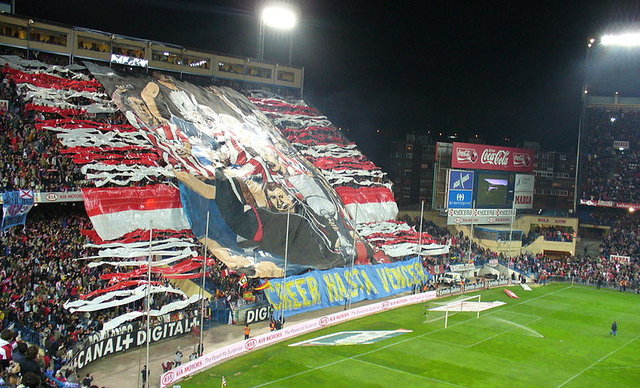
By Leandro Neumann Ciuffo (Torcida do Atlético de Madrid) [CC BY 2.0]
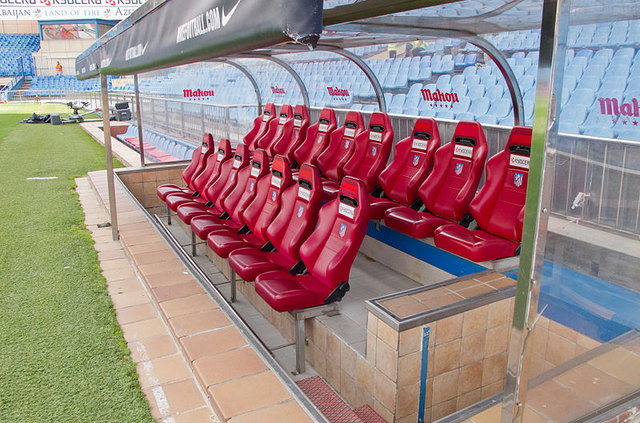
Carlos Delgado [CC BY-SA 3.0]
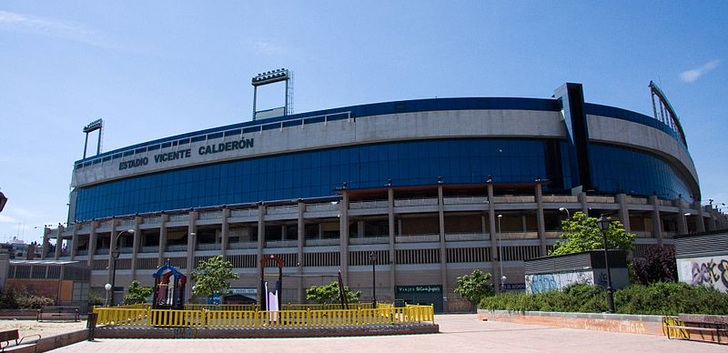
By JUAN RAMON RODRIGUEZ SOSA (http://www.flickr.com/photos/azuaje/4605081600/) [CC BY-SA 2.0]
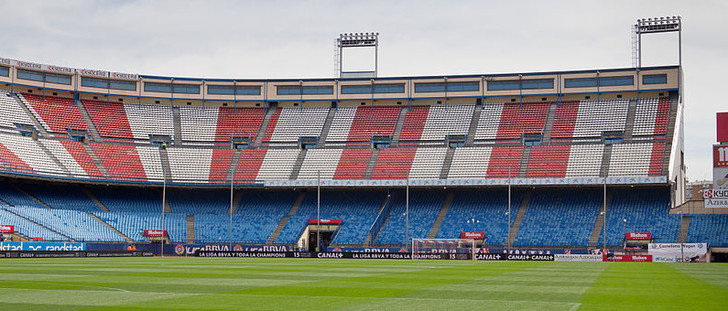
Carlos Delgado [CC BY-SA 3.0]
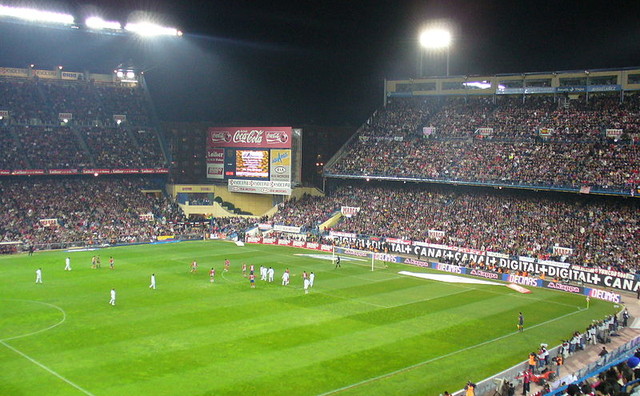
By Leandro Neumann Ciuffo (Estádio Vicente Calderón) [CC BY 2.0]
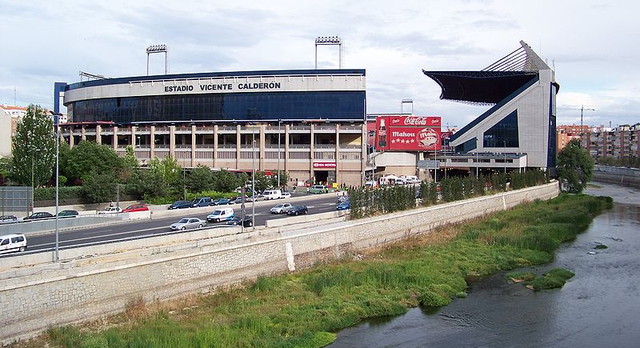
By www.vacacionesbulgaria.com (Own work) [GFDL or CC BY-SA 4.0-3.0-2.5-2.0-1.0]
Vicente Calderón Seating Plan and Where to Sit

The Vicente Calderón is a strange looking stadium, part ‘Bowl Style’ design and part ‘English Style’, three quarters of the ground is made up of continuous seating and one stand is a standalone section. Here’s a little bit of information about each:
- Fondo Norte – This stand is at the Northern end of the ground and is behind the goal. It is a two tiered section of seating with a row of executive boxes above the upper tier, rather than between the two tiers as is more common.
- Lateral – This, along with the Fondo Norte and Fondo Sur, makes up the U shaped section of partial bowl design in the ground. It is uncovered and, just like with the Fondo Norte, features two tiers and a row of executive boxes above the top tier.
- Fondo Sur – Making up the last part of the bowl section of the stadium, this section is sometimes called the Curva Sud and the most passionate Atlético fans tend to watch the games from here.
- Preferencia – The only part of the ground that is a standalone section is the Preferencia. It is also the only part of the stadium that has a roof, protecting it from the rare bit of bad weather that Spain sometimes gets. It’s the main section of the ground in so much as it contains the changing rooms, the players’ tunnel and the dugouts.
Getting To Vicente Calderón
Madrid is Spain’s capital city, so it’s reasonably safe to say that there are plenty of options for getting there. Here are some of the more traditional travelling methods that you’ll probably consider for your journey:
Train – Getting to Madrid from London by train is a mammoth journey that will take somewhere in the region of fourteen hours. Flying is the more sensible option, then, with your options of getting to the ground opening up in front of you once you’re there.
Train lines C-7 and C-10 are the ones you’ll want to look for, with Pirámides station being the closest to the stadium. Madrid has an excellent Metro system, too, with Line 5 stopping at both Pirámides and Marqués de Vadillo. Each of these stations is close to the ground.
Bus – Madrid’s bus service is nearly as good as its Metro options. There are a number of bus routes that call close to the ground, including bus numbers 14, 27, 40, 43, 120, 147 and 150.
Car – The Vicente Calderón is in the South-West of Madrid on the banks of the Manzaneras, with the M-30 motorway actually running directly underneath the main stand. Obviously sat-nav is the best way to go if you’re thinking of driving, but if you don’t have one then get onto that M-30 and you won’t be able to miss the ground.
By Air – Madrid – Cuatro Vientos Airport is just over ten miles away from the centre of the city and is served by most international airports. Alternatively you might want to consider Madrid – Barajas Airport, the airport that serves most domestic cities from elsewhere in Spain.
Taxi – A taxi from Barajas Airport to the stadium will take around twenty minutes and cost in the region of €30. If you get caught in traffic you will, of course, pay more as the journey will take longer.
Parking Near Vicente Calderón
There are car parks that are just five minutes walk from the ground, but they are reserved for holders of the club’s ‘parking ticket’. You might be able to find some on-street parking near to the ground but make sure you keep your eye out for any restrictions that might be in place.
Useful Resources
Vicente Calderón Hotels
We’re talking about Madrid here, the capital of Spain. There are hotels every three foot and if you close your eyes and spin around then when you open your eyes you’ll be looking at someone you can sleep 99 times out of 100. Here are our selections of hotels close to, or within easy travelling distance of, the stadium:
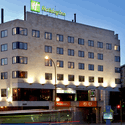
Holiday Inn Madrid Pirámides - £60+
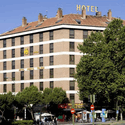
Hotel Puerta de Toledo - £85+
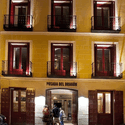
Posada del Dragón - £100+
Pubs and Bars Near Vicente Calderón
Tapas bars, restaurants, Irish pubs. Madrid’s got it all. Here are some of our favourite places for a pre-match pint:
Bar Alegre
The Towers Irish Pub
Casa Labra
Facilities
The stadium was built in the 1960s and updated in the 1980s, so it’s not exactly Victorian in build but it’s not super modern either. The facilities are fine, with plenty of places to get a drink or a bite to eat, but it’s not the most spectacular stadium you could visit in Spain.
Hospitality
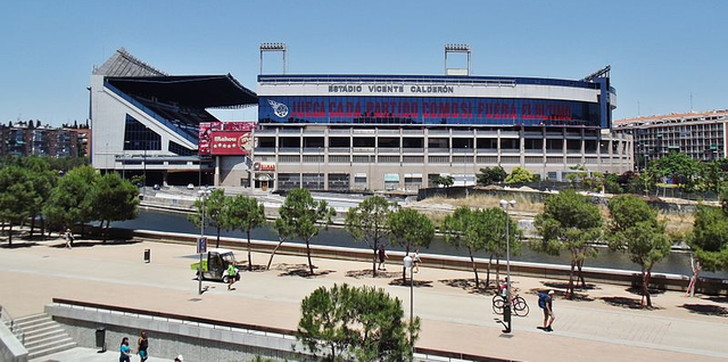
As with most grounds around Europe, the Vicente Calderón contains numerous places that can be used for hospitality purposes. There is the trophy room, for example, where you’ll enjoy a unique mix of modern design and elegance with the shadows of the club’s successful past. Your day will start with an exclusive reception before you get a bit to eat before the start of the game. Half-time will be spent in the club’s museum and you’ll enjoy great seats in the side stand.
The stadium also features lots of different VIP Boxes that you can enjoy the game from. You’ll get exclusive access to the room that also has its own toilet, hostess service and delicious food as well as padded seats from which to watch the action. If you’ve got the money to spend then it’s an ideal way to watch Atlético play.
Private Hire
You might be wondering if any part of Atlético’s stadium is available for private hire for events and the like and the answer is, of course, yes. The ground has a number of different lounges with available capacities from 25 people through to 1000. Whether you’re hoping to host a small, intimate dinner party or a larger, more spectacular business meeting or presentation then you’ll be able to do just that at the home of Atlético Madrid.
Stadium Tours & Museum
Atlético operate regular tours of the Vicente Calderón that take in numerous exciting parts of the ground that are normally hidden from regular people. You’ll get to see the dugouts, the pitch side area, the changing rooms and the press room. You’ll also get to have a look around the President’s Box and the VIP room where new signings are unveiled. The tours run every day of the year apart from the 24th, 25th and 31st of December and the 1st and 6th of January. Tours run at 12pm, 1pm, 4pm and 5.30pm.
The Atlético de Madrid Museum & Pablo Ornaque Collection invites you to travel back in time and enjoy the success of Atlético from days gone by. You can have a look around the museum with audiovisual guides and a look at some of the most interesting memorabilia around.
Vicente Calderón History
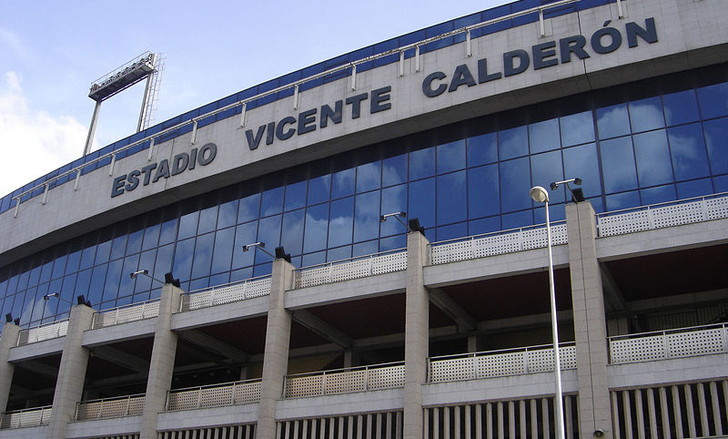
Atlético began their life playing their games at the Ronda de Vallecas, situated in a working class part of town to the South of Madrid. In 1921 they moved to a newly built stadium that had been erected by the company that ran Madrid’s underground system. The new ground was called Estadio Metropolitano de Madrid and remained the club’s home until they relocated once more to the purpose built Estadio Vicente Calderón in 1966.
Despite always standing in the metaphorical shadow of the Santiago Bernabéu, the Vicente Calderón was actually the first stadium in Spain to be classified as a 5 star Elite stadium according to UEFA. A claim to fame that doesn’t mean an awful lot, but there you are. It’s also the only ground in Spain to have a major motorway running directly beneath one of its grandstands. Take that, Real Madrid.
Future Developments
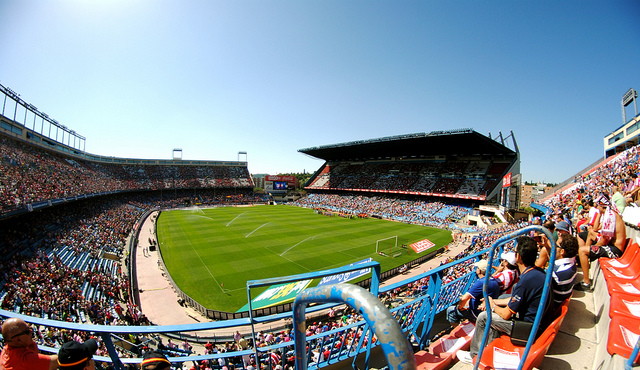
At the end of the 2016-2017 season Atlético will move to the newly renovated Estadio La Peineta. The ground was built when Madrid applied to host the 2016 Summer Olympics, but when the bid failed the ground needed a new guest. The capacity is being increased from 20,000 to 73,000 for the start of next season. As such, the only future developments likely to take place at the Vicente Calderón is its demolition in advance of a new waterfront park being built in its place.
